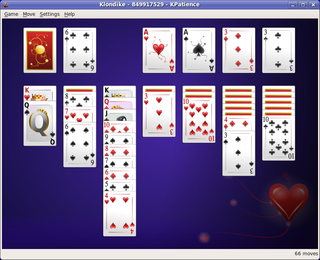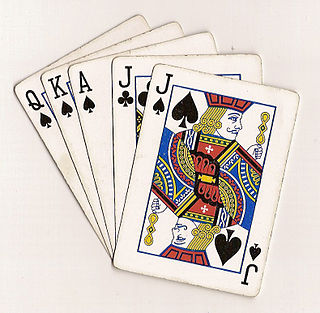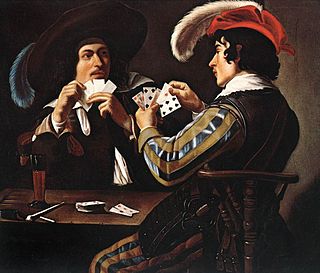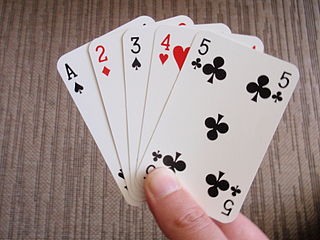
Solitaire is any tabletop game which one can play by oneself. The term "solitaire" is also used for single-player games of concentration and skill using a set layout of tiles, pegs or stones rather than cards. These games include peg solitaire and mahjong solitaire. Most solitaire games function as a puzzle which, due to a different starting position, may be solved in a different fashion each time.
Spit, also referred to as Slam or Speed, is a game of the shedding family of card games for two players. The game is played until all of someone's cards are gone.
President is a westernized version of an originally Japanese card game named daifugō or daihinmin. It is a game for three or more, in which the players race to get rid of all of the cards in their hands in order to become "president" in the following round. It can also be played as a drinking game. A commercial version of the game exists under the name The Great Dalmuti, with a non-standard deck.

500 rum, also called pinochle rummy, Michigan rummy, Persian rummy, rummy 500 or 500 rummy, is a popular variant of rummy. The game of canasta and several other games are believed to have developed from this popular form of rummy. The distinctive feature of 500 Rum is that each player scores the value of the sets or cards they meld. It may be played by 2 to 8 players, but it is best for 3 to 5. The term "Michigan Rummy" may also refer to an unrelated game involving a playing board, chips, and accumulated pots that are awarded to players who play certain cards.
Old Maid is a Victorian card game for two or more players probably deriving from an ancient gambling game in which the loser pays for the drinks. It is known in Germany as Schwarzer Peter or Schwarze Dame, in Sweden as Svarte Petter, in Norway as Svarteper, in Denmark as Sorteper, in Croatia as Crni Petar, in Slovenia as Črni Peter, in Hungary as Fekete Péter, in Czech Republic as Černý Petr, in Slovakia as Čierny Peter, in Finland as Musta Pekka, in Italy as Asino, in France as Le Pouilleux or Vieux Garçon, or Mistigri, and in Japan as ババ抜き (Babanuki). The game spawns an element of bluffing, commonly used in poker.

Cheat is a card game where the players aim to get rid of all of their cards. It is a game of deception, with cards being played face-down and players being permitted to lie about the cards they have played. A challenge is usually made by players calling out the name of the game, and the loser of a challenge has to pick up every card played so far. Cheat is classed as a party game. As with many card games, cheat has an oral tradition and so people are taught the game under different names. The game is called "I Doubt It" by Edmond Hoyle and is sometimes known as "Bullshit" or "Bologna" in the United States.
Slapjack, also known as Slaps, is a simple standard-deck card game, generally played among children. It can often be a child's first introduction to playing cards. The game is related to Egyptian Ratscrew and is also sometimes known as Heart Attack. It is also related to the simpler 'slap' card games often called snap.
Golf is a card game where players try to earn the lowest number of points over the course of nine deals. It is a game for four or more players using a double-deck of 108 cards, and has little in common with its solitaire cousin.

Rummy is a group of matching-card games notable for similar gameplay based on matching cards of the same rank or sequence and same suit. The basic goal in any form of rummy is to build melds which consists of sets, three or four of a kind of the same rank; or runs, three or more cards in sequence, of the same suit. If a player discards a card, making a run in the discard pile, it may not be taken up without taking all cards below the top card. The Mexican game of Conquian is considered by games scholar David Parlett to be ancestral to all rummy games, which itself is derived from a Chinese game called Khanhoo and, going further back, Mahjong. The Rummy principle of drawing and discarding with a view to melding appears in Chinese card games at least in the early 19th century, and perhaps as early as the 18th century, and is the essence of Mahjong.

Sheng ji is a family of point-based, trick-taking card games played in China and in Chinese immigrant communities. They have a dynamic trump, i.e., which cards are trump changes every round. As these games are played over a wide area with no standardization, rules vary widely from region to region.
Speed is a game for two players or more of the shedding family of card games, in which each player tries to get rid of all of his or her cards first.
Switch, also called Two Four Jacks, Black Jack or Irish Switch, is a shedding-type card game for two or more players that is popular in the United Kingdom, Ireland and as alternative incarnations in other regions. The sole aim of Switch is to discard all of the cards in one's hand; the first player to play his final card, and ergo have no cards left, wins the game. Switch is very similar to the games UNO, Flaps and Mau Mau, both belonging to the larger Crazy Eights or Shedding family of card games.
Ranter-Go-Round is a card game with bluffing elements.
Winner is a card game similar to the game President, the game Big Two, and other shedding games. It is the game from which Tien Len and other similar games are derived.
Mighty is a card game invented in the 1970s by Korean college students. Mighty is mostly played by Korean students, and also by some groups in North America. It is usually played by five people, but the number of cards can be modified so that it can be played by anywhere from 4 to 8 players. It is a point-trick game with bidding. It is similar to the card game Spades, but has more rules and, therefore, more strategies in playing. Mighty is also similar to Rook and Japanese Napoleon.
Buraco is a Rummy-type card game in the Canasta family for four players in fixed partnerships in which the aim is to lay down combinations in groups of cards of equal rank and suit sequences, there being a bonus for combinations of seven cards or more. Buraco is a variation of Canasta which allows both standard melds as well as sequences. It originated from Uruguay and Argentina in the mid-1940s, with apparent characteristics of simplicity and implications that are often unforeseeable and absolutely involving. Its name derives from the Portuguese word "buraco" which means “hole”, applied to the minus score of any of the two partnerships. The game is also popular in the Arab world, specifically in the Persian Gulf; where it is known as 'Baraziliya' (Brazilian).
Go Fish or Fish is a card game usually played by two to five players, although it can be played with up to 10 players. It can be played in about 5 to 15 minutes.

Euchre has many variations in game playing. Some of them are designed for two, three, five or even six hands. Described below are some of these variations. Some are called “Johann.”
Egyptian Ratscrew is a card game of the matching family of games. The game is similar to the 19th century British card game Beggar-My-Neighbour, with the added concept of "slapping" cards when certain combinations are played, similar to and perhaps borrowed from Slapjack.
















